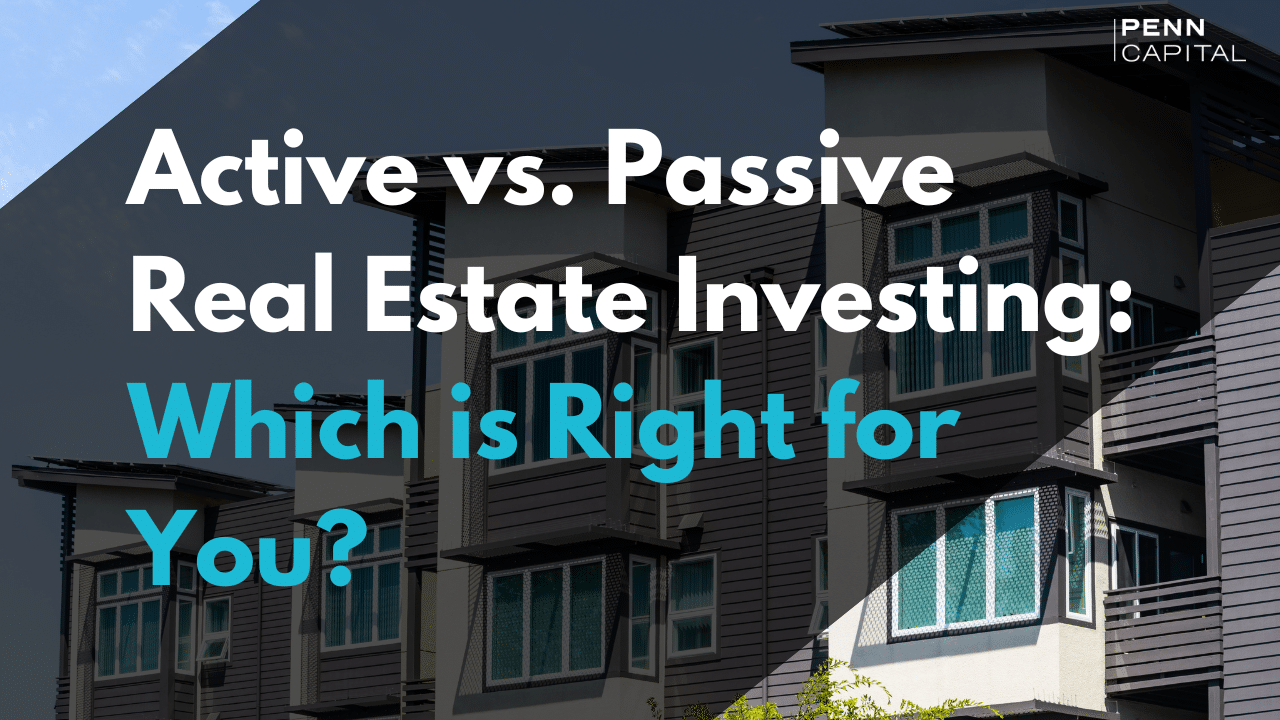Active vs. Passive Real Estate Investing – Which is Right for You?
By Ed Rogan, Owner, Co-Founder

Real estate investing has many benefits, from monthly cash flow to appreciation, tax benefits and more. Buy rental property, then just sit back and collect passive income, people are told. A well-intentioned investor who follows that advice might turn around and buy a single-family rental property, only to realize it’s a lot more work than they had expected.
And therein lies the difference between active and passive real estate investing – a distinction that many people overlook when investing in their first rental properties.
Active Real Estate Investing
Active real estate investing is when a person, entity or fund is directly involved in the investment process. In short, active real estate investing requires YOUR time, YOUR capital, and YOUR risk. An active investor is fully engaged in the process, either entirely from beginning to end, or heavily in parts of the process (such as acquisition or renovation). The level of commitment that’s required by active real estate investors often equates to a full-time job.
Active real estate investing can take different forms, from wholesaling to fix-and-flips.
Wholesaling is when a person ties up a piece of real estate – through a purchase and sale agreement, option to purchase or otherwise – and then sells the rights to that property to someone else. In this case, you aren’t actually investing in or exchanging real estate. You’re purchasing and selling contracts associated with that piece of real estate, usually for an assignment fee.
Then there are property flips. Investors often find an off-market deal, purchase the property at a discount, and then turn around and sell immediately for a profit. This can be lucrative, but it also requires a lot of work. Finding properties to flip is the biggest challenge, and is incredibly time intensive, particularly for someone wo doesn’t have much real estate experience or lacks local connections.
On the other end of the spectrum are major real estate renovation or development projects. These tend to be the most complicated real estate projects. There are a lot of moving parts, from negotiating land contracts to permitting, design, and construction. Once the project is built or rehab complete, you still need to lease units before generating cash flow. These projects tend to have a lot of unknowns. You must have an experienced team in place to be successful with this real estate investing approach.
Passive Real Estate Investing
Passive real estate investing, as its name would imply, is a way of generating passive income through real estate.
There are a few ways to passively invest in real estate.
You can invest in a real estate investment trust (REIT), which is like a mutual fund. Essentially, you’re buying stock in a real estate portfolio that is actively managed by the REIT. According to federal regulations, REITs are required to return 90% of profits to their investors. The benefit of buying into a REIT is that you can buy and sell its shares at any time. The asset class is more liquid than traditional real estate.
Another approach is to buy into a real estate investment fund, a process often referred to as syndication. Don’t let the fancy name throw you off – most people have participated in a syndication at one point or another. If you’ve ever purchased an airline ticket, you’ve participated in a syndication. You paid for your seat, as do others. In total, revenue generated by each ticket sale is used to pay the airline, pilot, government fees, etc.
Real estate syndication is similar.
You invest in a real estate deal alongside several others. Each project may have a different minimum requirement, say $25,000 or $50,000 per person. Investors share in the project’s risk and reward, with each being paid out a share of the profits accordingly. Usually the project sponsor will take a small administrative fee, but that sponsor usually falls at the bottom of the equity waterfall, meaning they are repaid last, only after investors have been repaid their equity stake at the agreed upon terms. A split of any profit above that threshold will go to the project sponsor.
One of the benefits of real estate syndication is that you, as an individual investor, are considered a “limited partner.” The only responsibility of an LP is to bring the capital. Meanwhile, the “general partner,” or GP, takes responsibility for finding and managing deals. Typically, the GP brings their real estate expertise in exchange for a share of the profits but is paid out only after the LPs have made their profits. This structure ensures that the GP/LP’s interests are always aligned.
Similarly, a real estate fund will pool investors’ resources and then can deploy that capital across an array of real estate projects depending on the goals of the fund.
After you invest in a REIT, real estate fund or syndicated deal, there’s not much more you need to do. Sit back, relax, and collect income accordingly. This is what most people have in mind when they decide to invest in real estate.
Sign up to receive our educational newsletter and to gain exclusive access to our next investment opportunity.
Active vs. Passive – Which Strategy is Right for You?
There are advantages to both active and passive real estate investing. It’s up to each individual investor to consider their specific circumstances.
- How much time do you have?
Active real estate investing is incredibly time intensive. You might have time to manage one or two rental units, but as a busy professional with a job to do or a business to run, can you realistically manage more than that? If not, passive real estate investing may be a better way to create both scale and sustained wealth through real estate.
- What level of risk are you willing to accept?
Active real estate investing tends to carry more substantial risk than passive real estate investing. Unless you’re experienced and knowledgeable about real estate investing, you might want to stick with passive real estate investing where a team of professionals will spearhead all active real estate activities, from acquisition to construction and ongoing property management.Moreover, with passive real estate investment, any risk is shared across multiple parties. If something goes wrong, you won’t be solely responsible for identifying and funding a resolution.
- What are the potential returns?
Before investing in a real estate deal, calculate the anticipated cash flow, cap rate, internal rate of return and cash-on-cash return. Not sure what how to do that? That’s a sign that you might want to start with passive real estate investing.
Conclusion
At the end of the day, real estate investing is about generating additional income. People wrongly assume that all real estate investing is passive – that’s simply not the case. Those who make this mistake will often quickly realize that buying, owning and managing real estate directly is a lot more time-intensive than they had anticipated.
Ready to stop working so hard for your cash? Start putting your cash to work for YOU through hands-off passive real estate investing by investing here with us at Penn Capital.
RELATED ARTICLES
5 Keys to Investing in Distressed Real Estate
5 Keys to Investing in Distressed Real Estate By Ed Rogan, Owner, Co-Founder Buying distressed real estate certainly isn’t for the faint of heart. An inexperienced investor can easily be swayed by the promise of a project sponsor who doesn’t actually have a plan for turning the property around. But that doesn’t mean you shouldn’t…
READ MORE >Gaining an Edge through Cold Calling
Gaining an Edge through Cold Calling By Ed Rogan, Owner, Co-Founder In many ways, commercial real estate is an “eat what you can kill” industry. The most successful investors, developers, brokers and other CRE professionals earn their living by scouring the market to uncover the next big deal. Ask the industry’s best and they’ll often…
READ MORE >Trial by Fire: How We Got Started
Trial by Fire: How We Got Started By Ed Rogan, Owner, Co-Founder People often use the term “trial by fire” to explain how they learned something. In our case, the term is all too appropriate. Looking back on it, the story of how Percy and I got started almost seems unbelievable. We were just…
READ MORE >


